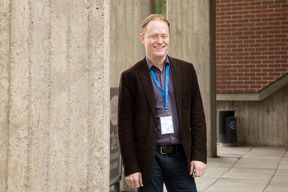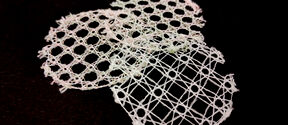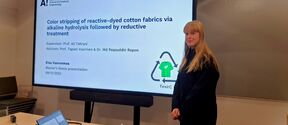Professor Björn Högberg: I don’t think people realize everything we can do with DNA

When you hear the word ‘DNA,’ what is the first thing you think about? Most people would probably say genetic material. But to DNA nanotechnologists, DNA is essentially a smart building material.
By mixing DNA in the right order, it can be used to create amazing molecular structures and machines, says Professor Björn Högberg from Karolinska Institutet, Sweden.
‘It’s completely different from what people think you can do. We can make nano rectangles and circles and bunnies. I don’t think people realize that.’
Högberg visited Aalto University in the end of May as he was invited to speak at the Nantech2019 workshop. His research group has often collaborated with the group of Pekka Orponen, Aalto University Professor of Computer Science.
In one of the joint projects, the researchers developed a method in which DNA strands can be folded into virtually any shape. The advantage of the novel method was that the process was fully automatized, enabling also creation of complex structures.
The results were published in Nature in 2015. To illustrate the power of the method, Högberg, Orponen, and their colleagues created a nano-sized bunny, attracting a lot of international attention.
‘The bunny itself of course isn’t important. The important thing is that it shows that we can actually do whatever we want with this technique,’ says Högberg.
In order to use DNA nanotechnology for more practical applications, researchers need to first become good in creating arbitrary shapes. The road from creating a nano bunny to learning more about communication of cancer cells or developing a new medicine is long. But taking these steps along the way is crucial.
‘You cannot just jump directly to making a new revolutionary drug without doing the groundwork.’
‘We can learn how cancer cells react’
Working at a medical university, Högberg is focusing on the biological applications of DNA nanotechnology. He is working with the so-called DNA origami method and molecular tools for detecting receptor activation and clustering receptors. In DNA origami, a single, long, natural DNA strand can be folded, in a similar manner as a paper origami, using a set of two hundred short, synthetic DNA strands.
In his work, Högberg is for example trying to define how cells in our body react to different types of receptor clusters. Receptors’ mechanism of action has been known for a long time, but how they work together is still unclear.
‘There are a lot of indications that the clustering, how they spatially arrange in the membrane, and how they assemble together, is important for what types of signals cells are receiving.’
Björn HögbergI think that almost all top-level science needs to be interdisciplinary to some extent, to be groundbreaking
By making use of the DNA origami method, researchers can study the way cells react to receptor clusters. ‘We can for example learn how cancer cells react. We might be able to understand what it takes for cancel cells to commit suicide.’
These types of discoveries could be very beneficial in designing better drugs. Overall, Högberg thinks that the applications of DNA nanotechnology are particularly useful in medical settings.
Science is always changing
Högberg’s background is in physics. In the beginning of his doctoral studies, he was working on superconductors, but at a later stage, he changed the topic to DNA self-assembly and got very interested in that. ‘That was something I thought was amazingly cool.’
Högberg was interested in research and working in academia already at an early stage of his studies. However, he doesn’t really believe people who say they knew already as children that they will become scientists. ‘I think it’s more of a coincidence that you end up where you are.’
According to Högberg, to become a successful scientist, one needs to be good at adapting and seeing what is interesting and what field has potential. The ability to switch focus from one topic to another is essential.
‘You can’t just do your PhD in one field and then stick with it forever because it’s not going to be relevant forever. Science is always changing.’
DNA nanotechnology is an interdisciplinary field where people come different educational backgrounds. Like Högberg, many researchers have initially studied physics, but others are experts in computer science, chemistry, or molecular biology.
‘I think that almost all top-level science needs to be interdisciplinary to some extent, to be groundbreaking.’
Read more news

Learning Centre opening hours during Christmas and year-end holidays
Thank you for the past year and have a wonderful holiday season!
Smart textiles are reshaping our understanding of materials – and interspecies communication
The PAST-A-BOT research project, funded by the European Research Council (ERC), is developing soft, intelligent textiles that could one day function as rescue robots, sound-sensing agricultural fabrics, or assistive clothing. At the same time, the project aims to rethink the way we approach materials research.
Master’s student showcases efficient color stripping of cotton fabrics
On December 9, master’s thesis student Elsa Vuorenmaa from the Textile Chemistry Group presented the results of her research on color stripping of reactive-dyed cotton fabrics.






